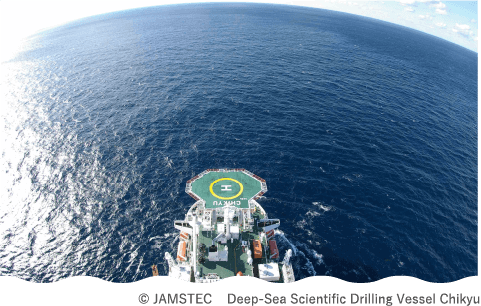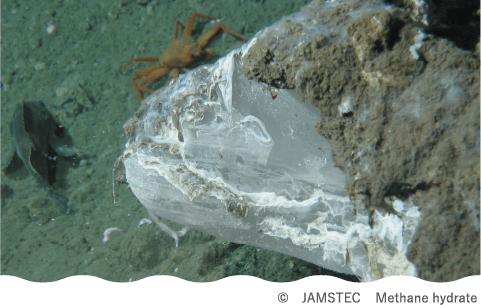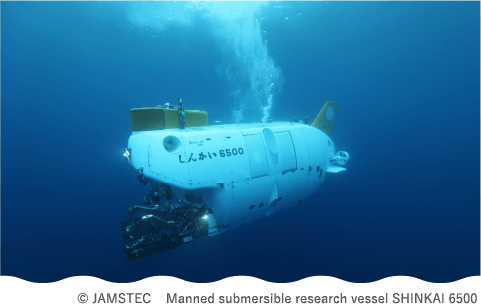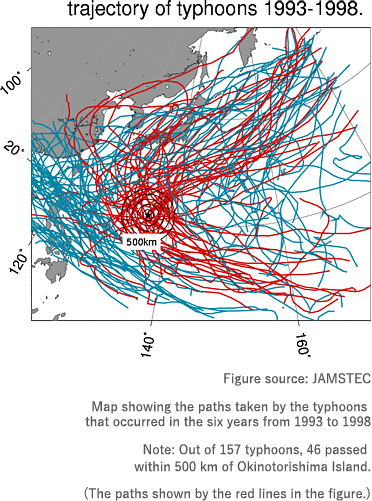

A.Basically, I take samples from the sea and use them to do chemical analyses and genetic analyses of living organisms, so I sail out on the research ships myself. JAMSTEC has people who operate the ships and people who operate the unmanned probes—i.e., robots—carried on board, and they all work together based on their specialist fields. As a researcher, I might for example request something like, "Please collect samples of this phenomenon in this way." If it's mud on the seabed, then the environment changes with depth, so we want to avoid disturbing things as far as possible. As the research proceeds, the researchers turn the collected samples into data by performing various analyses both on board and back on land. It's also the researchers' job to write voyage proposals, like, "I want to use a ship to do such and such research."

A.There are specialists for each research theme we want to work on, so we approach experts for each one, put together a team of 10 or 20 people, then say, "Right, let's get on a ship and go." That's how the research goes.

A.Yes. As you may know, we have a manned submersible called SHINKAI 6500, and I sometimes go down in it to take samples. We only have one of them, so I don't get to ride in it very often. However, we have robots—i.e., unmanned probes—that can do the same things as SHINKAI 6500. We lower them into the water on cables, and get them to take samples by controlling them from aboard ship back up on the surface. From aboard ship up at sea level, we control probes in the deep sea thousands of meters below while monitoring what their cameras are seeing, and get them to pick things up, suck in water, and so on. However, we also only have a limited number of probes that can do things like that. A more classical, analog approach we also use is to lower a tube-like device resembling a plastic soda bottle down from the ship to a depth of 5,000 or 10,000 m, then send an electrical signal to close it and get a water sample from that depth. We use various technologies, but in any case, the idea is to bring samples back and analyze them.

A.It depends on the size of the ship. Ships can only carry a limit amount of water, fuel, and so on, so if it's a short voyage—i.e., from port and back—we'll go for about a week before resupplying. At JAMSTEC, two- to four-week voyages are common.

A.I went to Okinotorishima Islands in 2006. There's a ship called HAKUHO MARU that originally belonged to the University of Tokyo but is now run by JAMSTEC. That's the ship I took to Okinotorishima Islands in 2006. As you know, Okinotorishima Islands is an atoll, and large research ships like HAKUHO MARU can't get right up to it. So, we got as close as we could in the ship, then lowered a boat from it and approached the island in that. That time, we investigated Okinotorishima Island's coral reefs.
Coral skeletons preserve a record of what the environment was like eons ago, and there are groups or researchers who study coral samples in detail to understand what it was like. The field is called "paleoenvironmental reconstruction." Coral reefs are usually found around an island, and when rain falls on the island, it passes through the soil, forms rivers, and flows into the sea. This has a significant effect on the coral reefs. However, Okinotorishima Islands is completely devoid of plants and soil. Of course, there aren't any rivers either, so there's no such effect. That said though, when it rains a lot like in a typhoon, the seawater around Okinotorishima Islands gets slightly desalinated. That means the environmental information recorded in the coral reefs only changes when a typhoon comes. I went to Okinotorishima Islands 15 years ago to investigate whether detailed examination of the skeletons of corals collected there would reveal things like when a brief typhoon might have passed the island, or around what month several decades ago a big one might have.

A.For example, there's less life than around the coral reefs of Okinawa's main island. The reason not much lives there is that not many nutrients come from the land, and the ocean around it is low in nutrients in the first place.
A.Environmental assessments can only be done using the technologies we already have, but at the same time, I also really want to introduce entirely new technologies and use them to learn even more about the deep sea. For example, for the past two years, I've been studying sound in the ocean. On land, we can see Mt. Fuji from Yokosuka for example, but even if we shouted "Aaah!" at it, there's no way the sound would reach it. In the ocean however, the way light and sound propagate is the opposite. Even a powerful light will only reach about 20 m away, but sound really travels well underwater, and can easily reach several kilometers away. So for example, maybe we can use this property with Edokko-1. Its cameras can only see about 10 m ahead even with the lights on, but if we use Edokko-1 to record sounds precisely, maybe we'll be able to tell what's happening up to 10 or 100 km away.
A.Yes, it's exactly sound waves. Since sound waves travel really well through water, we should be able to use them to determine what's happening in the ecosystem. For example, if a certain sound approaches then recedes again, it could mean there was such and such a creature. Or if we take a long sound recording around Minami-Tori-shima Island, then do it again after seabed resources have been developed there, the sounds might have changed. So then we might say, "Maybe this sound has disappeared because this creature that was there before the development isn't there anymore," or, "There's a sound now that wasn't there before, so maybe this creature has come along and started to live there." I want to study things like that using sound.